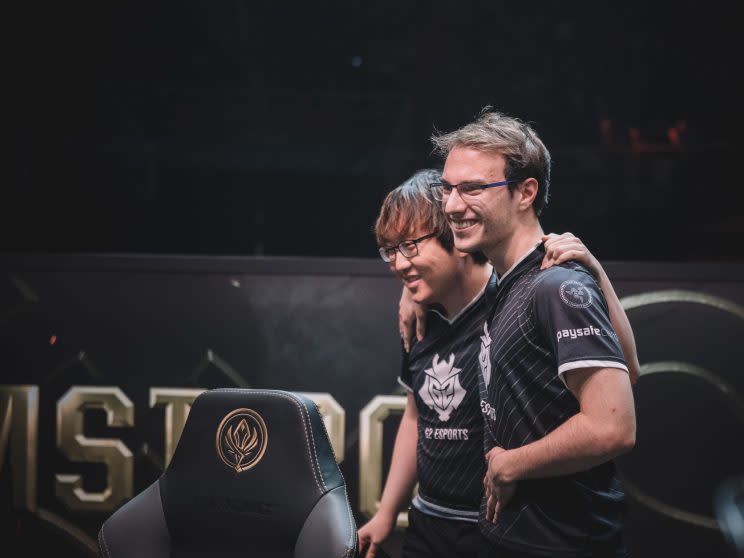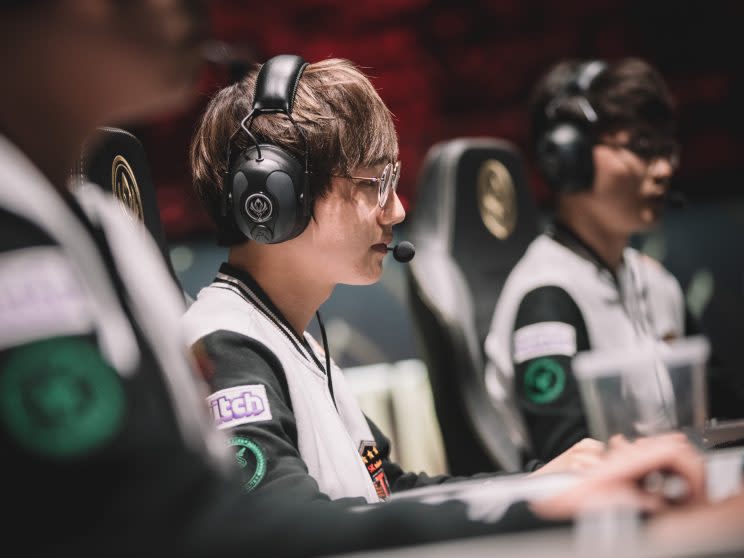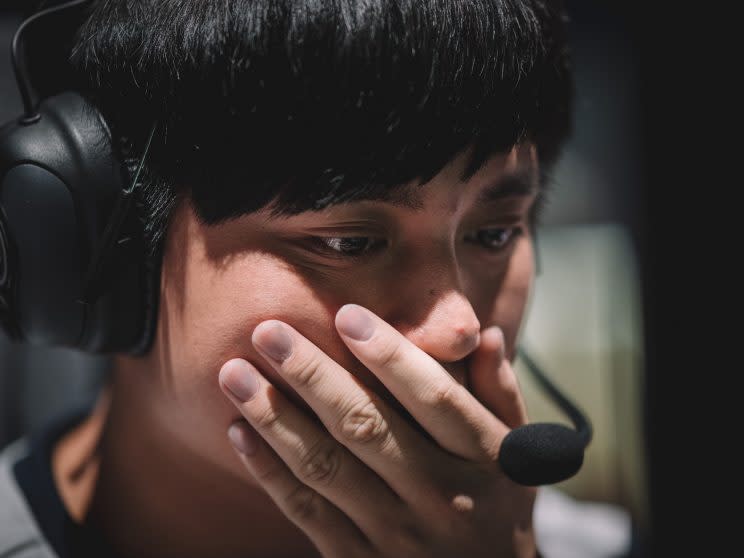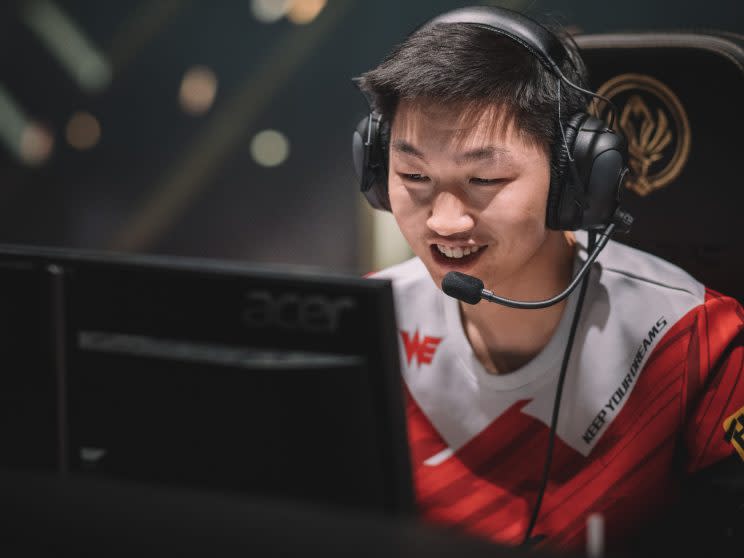Not as close as it looks: The surprising lack of comebacks in 2017 MSI Round 1

After 40 minutes of scratching through turrets with a lead borne from solo lane push advantages, Team SoloMid’s League of Legends‘ squad fumbled a Baron teamfight to turn the last 10 minutes into objective trades that gambled the entire match. Caster David “Riot Phreak” Turley would later refer to Team SoloMid’s 50 minute base race win over G2 Esports as “the strangest game” he had cast.
Taking down an opposing Nexus within one auto-attack only to lose might be rare, but many analysts anticipated back-and-forth games at this 2017 Mid Season Invitational. With the exception of Flash Wolves and Gigabyte Marines, none of the teams qualifying for the event came with a reputation for quick and decisive laning phases. Teams’ tendencies towards more conservative starts, smaller average gold leads at 15 and 20 minutes, but also imperfect lane assignments in the midgame make MSI throws and comebacks predictable.
The first round of MSI matches have played out somewhat awkwardly; however, comebacks and throws aren’t as common as they might seem. In a little more than two-thirds of the games, the team with the gold lead at 20 minutes has won the match, and only two games have had comebacks from a more than 2,000 gold deficit at 20 minutes.
While Flash Wolves, Gigabyte Marines, Team WE, and Team SoloMid have all lost games with gold leads at 20 minutes, fewer teams have made comebacks. Flash Wolves and G2 Esports have had two turnaround wins after deficits at 20 minutes, and SK Telecom T1 has managed one rebound with a Baron steal after a small 1,600 gold deficit at 20 minutes. Flash Wolves’ win over GAM resulted after a 5,800 gold deficit at 20 minutes, and G2’s first win over Flash Wolves came after they fell behind 2,800 gold.
The volatile first round robin ended with every team except SKT finishing with a 2-3 win-loss record. The slightest advantage or disadvantage could now make the difference between qualifying for the bracket stage or falling out of the tournament. Understanding where early game deficits arise and how Flash Wolves and G2 made their comebacks might shed some light on how the final days of MSI’s Group Stage could shake out.
Slow jungle choke
Nearly every team entering MSI’s main stage received domestic praise for their mid and jungle duo. One might imagine a dominating 2v2 force that crushes the opposition in skirmishes and snowballs the game, but for teams like SKT, Team WE, G2 Esports, and TSM, a strong mid and jungle duo means something different. Each mid laner has a reputation for pushing out the lane and allowing his jungler to invade or take control in a side lane.
In terms of the jungler’s actual mid lane impact, TSM’s Dennis “Svenskeren” Johnsen takes the most active role. Even then he mostly uses Søren “Bjergsen” Bjerg’s push priority to invade the enemy’s blue buff or exert gank pressure on the top lane. As a result, mid and jungle control becomes a much slower process.
These mid laners rely on strong 1v1 matchups or threat of a strong 2v2 matchup with their jungler to get push priority. This means, for each of these teams, holding mid for last pick to get a counter isn’t uncommon. A mid laner keeps the wave pushed to let his jungler invade, lay down wards, and make follow up plays later.
In this way, one establishes a difference between a poor early game and a slow early game. For example, Team WE was characterized by the desk as a team that “rests on their laurels and gives up the early game,” but they gain many advantages by having Su “xiye” Hanwei and a side lane push out. Xiang “Condi” Renjie can then invade and acquire a strong individual lead, becoming much more oppressive in teamfights or mid game skirmishes.
Team WE’s playstyle gives them control of the early game slowly, reflected in the fact that they have averaged the second highest 20 minute gold lead of the tournament at 1,090. But they have a simple technique. With variations, this kind of mid push and jungle control strategy is a basic staple of almost every team at the tournament.
SKT, for example, use side lanes more often to influence the mid lane push. For example, when they draft an assassin mid laner, they might want to pick up a more supportive top laner who can Teleport for a mid play. That way, Lee “Faker” Sanghyeok may feel less threatened when he picks lower wave clear and poorer trade picks at early levels. He can keep pushing aggressively to facilitate Han “Peanut” Wangho to lay down vision. SKT have had a gold advantage at 20 minutes in every match but one at MSI, despite a reputation for weaker early game play.

Flash Wolves and G2 Esports have had the most games with a gold deficit at 20 minutes. Flash Wolves lost the only game where they accumulated a gold lead at 20 minutes of 2,800 to G2. They averaged the largest gold deficit at 20 minutes in the first round at 2,461.
G2 acquired their only gold lead at 20 minutes — a monstrous 10,200 gold lead – against Flash Wolves in their first match of the second round of Group Stage. Because of that large lead, G2 average only a 163 gold deficit at 20 minutes, but without it, they’ve maintained an average 2,236 gold deficit at 20 minutes to teams in the first round.
Flash Wolves’ surprise deficit
The Flash Wolves numbers shocked many expecting the LMS giant to come in as the major region team most preoccupied with the laning phase. In the LMS playoffs, they averaged a 15 minute gold lead of 2,469, and against Super Massive at MSI’s Play-in, they averaged a 15 minute lead of 2,038.
Flash Wolves’ confusion against GAM is evidence of a fumbled early game. When the Vietnamese team started with a level one lane swap, rather than pressure the bottom lane turret or make an invade play on GAM’s red buff, Flash Wolves split their resources and accomplished neither objective.
While I previously thought of Flash Wolves’ tendency to over-group or simply take advantage of poor mistakes by their domestic competition as a reason the team may be overrated going into MSI, I didn’t anticipate a change in their mid lane draft tactic.
Curiously, Flash Wolves have prioritized more scaling mid lane picks in the Group Stage so far. In five out of six of their matches, they’ve chosen a weak early game mid lane matchup either by early picking their mid lane champion or prioritizing Ryze.
During LMS Playoffs, Huang “Maple” Yitang prioritized assassin picks that can trade aggressively like Zed or Talon or high roaming champs with good initial wave clear like Taliyah or Aurelion Sol. At the MSI main stage, Maple has played one strong lane matchup (Ryze into Leblanc) and has statistically fallen behind in lane.
With an average gold deficit of 205, experience differential of 206, and CS deficit of 3.3 at 10 minutes for MSI’s main stage, Maple has had the worst laning stats of any mid at MSI. Regarded as one of the best mid laners going into the event, it seems surprising that Flash Wolves would handicap their mid laner when they’re used to giving him a strong matchup.
When Maple can’t push out the lane with a strong matchup, it also becomes more difficult for jungler Hung “Karsa” Hauhsuan to get control of river scuttle or exert pressure in side lanes. The question becomes, then, why Flash Wolves might take this different approach.
Yu “MMD” Lihung, from Flash Wolves’ opening match against Team WE, has been targeted much more often in the early game. Flash Wolves have adapted by picking a scaling Ryze or even adding a scaling ADC to prepare for late game teamfights. Against GAM, Flash Wolves’ double Tear of the Goddess composition gave them the largest comeback of the tournament so far.
Aside from awkward drafts, FW have had to contend with more holes in early game macro since we last saw them at an international Riot event. Though often criticized for poor teamfight positioning, previous AD carry Hsiung “NL” Wenan forced Flash Wolves into creative early game strategies. They looked for ways to open a side lane for him to freeze early, which meant trading turrets, snowballing the game, and opening the map for Karsa.
Overall, Flash Wolves have appeared less imaginative at this MSI. They leave their bottom lane on utility picks, sacrifice their side lanes, and hold onto the mid lane to scale up. This is far from the Flash Wolves we remember.
G2 Esports playing to expectations
Given G2’s supposed interest earlier this year in training their mid game at the expense of laning phase training, it’s less surprising to see them losing before 20 minutes. Like Flash Wolves, they have drafted a great deal of scaling compositions, some of them one-dimensional and over-reliant on Jesper “Zven” Svenningsen.
Unlike Flash Wolves, however, G2 haven’t accrued unexpected deficits by sacrificing mid lane push. On the contrary, Luka “Perkz” Perkovic has finally had a breakout performance at an international event, with highlight Fizz plays responsible for dragging them back into their match against Gigabyte Marines in Round 1. Perkz has also maintained strong laning stats relative to Maple, with advantages in CS, experience, and gold at 10 minutes.

Instead, G2 have struggled with using some of their push advantages optimally to secure the jungle. In the match against Team SoloMid, for example, G2 pinged Svenskeren when he entered his own bottom side jungle. Kim “Trick” Gangyun went to make a play on top side, relying on his pushing mid and bottom lane to keep tabs on Svenskeren. He over-estimated the team’s ability to execute the top play quickly, and TSM collapsed on Perkz, chasing him into the top side jungle where TSM members trapped Perkz and Trick so they could use the area of effect of the Rumble ultimate.
G2 may have been better off pushing out mid to turret, then coordinating the roam top with mid laner in tow to avoid the flank setup in jungle. These fragmented plays and failed executions aren’t surprising given G2’s EU LCS play. They may be able to identify a strong side, but often don’t path correctly.
Trick has also spent an unusual amount of time this tournament hovering around mid lane despite Perkz’s ability to control the lane himself in a strong matchup. Inefficient use of time, coupled with some weaker jungle picks like Nunu, has prevented G2’s usually efficient carry jungler from having his an impact.
An overall disappointing level of mid game play
With Flash Wolves and G2 Esports lagging in the early game and their generally poor execution of lane ganks, one might expect more decisive comebacks. Only five successful comeback games of 18 have so far graced MSI’s Group Stage after the 20 minute mark, and only two have been from gold deficits over of 2,000 gold. MSI’s back-and-forth nature may have been overstated.
Even with fumbled early games, Flash Wolves and G2 Esports have had weak lane assignments and general midgame confusion. A desire to draft teamfighting and scaling compositions may reflect a poor ability to play 1-3-1 or split pressure across the map with strong macro. G2’s AD carry Zven said it himself in the post-game interview after the team’s comeback against GAM.
“We didn’t know how to play split-push against this — or their comp — so we were like lost in the game of what to do, and we took one bad fight, and it kind of collapsed a little bit, and we were like lost of how to play the game. We decided… just ARAM it.”
G2 had a similar approach against Team WE, but lost to WE’s ability to maintain 1-3-1 and keep vision in blue side’s blue buff area. They targeted Zven with Ashe arrow and used the burst from Graves to counter shields and whittle G2 down. Flash Wolves have used Ryze to play catch up and collapse on Baron fights when they find themselves out-rotated.
These one-dimensional approaches don’t speak highly of either Flash Wolves or G2’s midgame macro play.
Further underlining this point, a lot of games have come down to team fights around Baron, and warding the red side red buff area has become paramount. Teams can use strong top laners to secure vision for setups and zone enemies off with long range AD carries. Four of five successful comeback games have been from red side, reflecting the importance of maintaining vision in the red side red buff area and keeping top side wave control in setting up for Baron teamfights.
Teams like G2 and Flash Wolves have had surprisingly confused early games and poor midgame lane assignments; however, they aren’t unique in their struggles.
Team SoloMid have also had difficulty in pressuring leads, lacking an ability to rely upon securing leads when they invade against pushing top and mid lanes. Team WE’s in ability to identify their own strong side in their first game against TSM and their scattered lane pressure against SKT also reveal gaping flaws in all stages of the game. As a result, Gigabyte Marines have been able to secure wins against WE and TSM simply by wedging in surprising brute force strategies around their jungler.

MSI so far hasn’t been a question of early or mid game fumbles. It hasn’t been about weak early game teams and epic comebacks. MSI has simply reflected massive gaps in basic execution in all phases of the game.
The fact that Flash Wolves and G2 have only been able to get early leads against each other and have only pulled off major comebacks against themselves or GAM doesn’t bode well for scaling teamfight drafts. More focus on laning, given a lack of strong execution in mid game, might be the key to a top four finish in a close MSI race. How teams want to prepare for bracket after that is up to them.
You can follow Kelsey Moser on Twitter @karonmoser.

